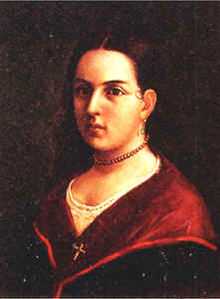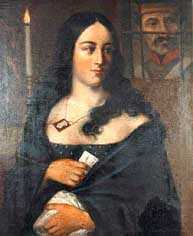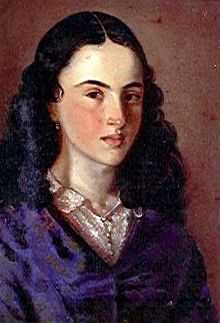Policarpa Salavarrieta
| Policarpa Salavarrieta | |
|---|---|
|
Heroine of the Colombian Independence Movement | |
| Born |
26 January 1795 Guaduas, Viceroyalty of New Granada |
| Died |
14 November 1817 Bogotá, United Provinces of New Granada |
Resting place |
Church of San Agustín, La Candelaria, Bogotá, D.C., Colombia |
| Nationality | Neogranadine |
| Occupation | Seamstress and spy |
| Religion | Roman Catholic |
| Parent(s) |
Joaquín Salavarrieta Mariana de Ríos |
Policarpa Salavarrieta (c. 1795 – 14 November 1817), also known as "La Pola," was a Neogranadine seamstress who spied for the Revolutionary Forces during the Spanish Reconquista of the Viceroyalty of New Granada. She was captured by Spanish Royalists and ultimately executed for high treason. She is now considered a heroine of the independence of Colombia.
Because her birth certificate was never found, her legal given name is unknown. The name Salavarrieta is known only by the names her family and friends used. Her father referred to her as Apolonia in his will, which Salvador Contreras, the priest who formalized the testament on 13 December 1802, confirmed.[1] She was closest to her brother, Viviano, as she became his caretaker when her parents died. When the armed forces in Guaduas started looking for her, she began calling herself Policarpa.
In her 1817 forged passport, used to get in and out of Bogotá during the Reconquista, she appeared as "Gregoria Apolinaria." Andrea Ricaurte de Lozano, whom Policarpa lived with, and officially worked for in Bogotá, as well as Ambrosio Almeyda, a guerrilla leader to whom she supplied information, also called her by that name. Her contemporaries referred to her simply as "La Pola," but Policarpa Salavarrieta is the name by which she is remembered and commemorated.
Place and date of birth
La Pola's date and place of birth are also subject to conjecture in the absence of legal documents. The popular version is that she was born in the municipality of Guaduas, Cundinamarca, between 1790 and 1796. However Rafael Pombo affirmed that she had been born in Mariquita, while José Caicedo Rojas confirmed it as Bogotá.
Her date and place of birth can be surmised from information available about her siblings which, curiously enough, were not lost.
Her siblings were:
- María Ignacia Clara, born in the San Miguel parish of Guaduas August 12, 1789 – 1802
- José María de los Ángeles, baptised in Guaduas on August 12, 1790 - became an Augustinian friar
- Catarina, born in Guaduas, 1791
- Eduardo, born in Guaduas on November 3, 1792 – 1802
- Manuel, born in Guaduas on May 26, 1796 - also became an Augustinian friar
- Francisco Antonio, baptised in the Santa Bárbara parish, Bogotá, 26 September 1798
- Ramón, confirmed in Bogotá in 1800
- Bibiano, baptised in Bogotá, 1801.[2]
Judging by these family records and the fact that Policarpa was born between her two religious brothers, she would appear to have been born between 1791 and 1796. The records also seem to indicate that the Salavarrieta family lived in Guaduas and moved to Bogotá after Manuel was born in 1796.
In an attempt to reconcile the discrepancies the Colombian Academy of History gave its final ruling on September 10, 1991, in favour of Guaduas, Cundinamarca, as Policarpa's birthplace.[3]
Early years

Without being titled or of the hidalgo class, Policarpa's family were apparently respectable and well-off, judging by her childhood home in Guaduas, now a museum. The Salavarrieta Ríos family moved to Bogotá between 1796–1798, living in a small house in the Santa Bárbara neighborhood.
In 1802 a smallpox epidemic broke out in the capital, killing thousands, including Policarpa’s father, mother, brother Eduardo and sister María Ignacia. After the tragedy, the family fell apart: José María and Manuel joining the Augustinian order, Ramón and Francisco Antonio traveled to Tena where they found work on a farm. Catarina, the oldest surviving child, decided to move back to Guaduas around 1804, taking her younger siblings Policarpa and Bibiano with her. They lived in the houses of their godmother Margarita Beltrán and their aunt Manuela until Catarina married Domingo García, again taking her two siblings with her.
There is little information about this period in Policarpa's life. What is known is that she worked as a seamstress, and is also believed to have worked as a teacher in a public school.
At that time Guaduas was an important rest stop on the most important road through New Granada, a stretch of land from Bogotá to the Magdalena River communicating with the north of the country and out to the Caribbean Sea: soldiers, nobles, artisans, farmers, insurgents, Spaniards and Grenadines of all walks of life passed through Guaduas, making it both a centre of commerce and of news and information. During the war, Policarpa's family were involved on the Revolutionary side: her brother-in-law, Domingo García, died fighting alongside Antonio Nariño in the Southern Campaign, in which her brother Bibiano also fought.[4]
According to legend, after the Revolution broke out, the Viceroy Antonio José Amar y Borbón and his wife María Francisca Villanová, fearing for their lives, were smuggled out of Bogotá by the mayor José Miguel Pey de Andrade. They stopped in Guaduas, where the Vicereine, María Francisca Villanová, is supposed to have gone to Policarpa's house and foretold her imminent destiny and death.
Revolutionary
History indicates that Policarpa was not involved in politics before 1810, but by the time she moved back to Bogotá in 1817, she was actively participating in political issues. Because Bogotá was the stronghold of the Reconquista, where most of the population were Spanish Royalists and approved of the take over by Pablo Morillo, it was very difficult to get in and out of the city. Policarpa and her brother Bibiano entered the capital with forged documents and safeguards, and a letter of introduction written by Ambrosio Almeyda and José Rodríguez, two Revolutionary leaders; they recommended she and her brother stay in the house of Andrea Ricaurte y Lozano under cover of working as her servants. In reality Andrea Ricaurte's home was the centre of intelligence gathering and resistance in the capital.
In Guaduas, Policarpa was known as a revolutionary. Because she was not known in Bogotá, she could move freely and meet with other patriots and spies unsuspected. She could also infiltrate the homes of the royalists. Offering her services as a seamstress to the wives and daughters of royalists and officers, Policarpa altered and mended for them and their families; at the same time she overheard conversations, collected maps and intelligence on their plans and activities, identified who the major royalists were, and found out who were suspected of being revolutionaries.
Policarpa also secretly recruited young men to the Revolutionary cause; with assistance from her brother. Together, they helped increase the number of soldiers the insurgency in Cundinamarca desperately needed.
Capture

Policarpa's operations ran smoothly and undetected until the Almeyda brothers were apprehended while carrying information back to the insurgents outside Bogotá. Their information directly linked La Pola to the Revolution. The Almeyda brothers and La Pola were implicated in helping soldiers desert the Royal Army and join the Revolution; transporting weapons, ammunitions and supplies to the insurgents; in helping the Almeydas escape from prison when they were captured in September of the same year, and finding them refuge in Machetá. They had hoped their connection with La Pola could come in handy in the event of a revolt in the city. The loyalists now suspected her of treason, but lacked solid evidence to accuse a seamstress of espionage and treason.
The arrest of Alejo Sabaraín while he was trying to escape to Casanare was the event that allowed the royalists to arrest La Pola; he was apprehended with a list of Royalist and Patriots given to him by Policarpa.
Sergeant Iglesias, the principal Spanish officer in Bogotá, was charged with finding and arresting her. Policarpa Salavarrieta and her brother Bibiano were both arrested at the house of Andrea Ricaurte y Lozano and taken to the Colegio Mayor de Nuestra Señora del Rosario, which had been turned into a makeshift prison.
Trial and death
They were taken to the Council of war and on November 10, Policarpa, Alejo, and six other prisoners were sentenced to execution by firing squad,[5] set for the morning of November 14, 1817.
The hour chosen for her execution was nine in the morning of November 14. Hands bound, La Pola marched to her death with two priests by her side and led by a guard. Instead of repeating the prayers the priests were reciting, she cursed the Spaniards and predicted their defeat in the coming Revolution. It is said that La Pola cursed the Spaniards relentlessly during the night before her execution. At one point she stopped, tired and thirsty, and one of the guards offered her a glass of wine. She tossed the glass right back at her captors, proclaiming "I would not accept even a glass of water from my enemies!".
She was to die with six other prisoners and her lover, Alejo Sabaraín, in the Bolívar Square. After ascending the scaffold she was told to turn her back, as that was the way traitors were killed. As she was led to her execution, Policarpa gave heart to the other prisoners and berated her captors. La Pola, refusing to kneel to the Spanish firing squad, yelled, "I have more than enough courage to suffer this death and a thousand more. Do not forget my example." When the squad began shooting, Pola turned around to face the squad.
As was customary, the bodies of Alejo and the other six prisoners were paraded and exhibited through the streets of Bogotá, to scare off would-be Revolutionaries. Being a woman, she was spared this final humiliation.
Her Augustinian friar brothers, José Maria de Los Ángeles and Manuel Salavarrieta, claimed the body, to give her a proper Christian burial in the convent church of San Agustín, in the neighborhood of La Candelaria.[6]
Commemoration
Day of the Colombian Woman
On November 8, 1967, Law 44 was passed by the Congress of the Republic of Colombia and signed by President Carlos Lleras Restrepo, which declared in its 2nd Article that November 14 would be the “Day of the Colombian Woman” in honour of the anniversary of the death of “Our heroine, Policarpa Salavarrieta”.[7][8]
Colombian currency
Policarpa Salavarrieta has been depicted on Colombian Currency many times over the years. While many idealized or mythological female figures have also appeared, her portrait is the only one of an actual female historical personality ever used. Other images include: Lady Liberty; Justice; an unknown Native American woman representing all indigenous peoples in Colombia; and more recently María, a fictitious character from the Jorge Isaacs novel of the same name, pictured with the author. The "Diez Mil Pesos" bill ($10,000) is currently the only denomination with Policarpa Salavarrieta's image still in circulation.
Postage stamps
To commemorate the 100th anniversary of the independence of Colombia in 1910, the Government of Colombia issued a series of stamps that featured the images of the some of the Heroes of the Independence, including Policarpa Salavarrieta, Simón Bolívar, Francisco de Paula Santander, Camilo Torres Tenorio and others.[9] Between 1903 and 1904 the Department of Antioquia issued a blue 3 pesos stamp depicting La Pola (Scott catalogue, Antioquia number 154).
-

$2 Colombian Pesos banknote, (1972)
-

$10,000 Colombian Pesos banknote, in circulation
-

1¢ commemorative stamp (1910)
-

$3 Antioquia stamp (1903–04)
-
La Pola, 1910 by Dionisio Cortés Mesa. Bogotá.
In popular culture
- Carolina Ramírez played Salavarrieta in La Pola, a 2010 RCN TV telenovela based on her life.
References
- ↑ Will of Joaquin Salavarrieta, to Doctor D. Salvador Contreras, Protocol of the 3rd Notary of Bogotá, scrivener Pedro Joaquín Maldonado, 1802, “Archivo General de la Nación”, folders 229v. to 231v and 289r to 291v.
- ↑ Tome XII of the “Boletín de Historia y Antigüedades” Bulletin of History and Antiquities
- ↑ "Policarpa Salavarrieta" (in Spanish). National Museum of Colombia. Retrieved 2007-11-21.
- ↑ "Salavarrieta, Policarpa" (in Spanish). Gran Enciclopedia de Colombia. Retrieved 2007-11-21.
- ↑ Arismendi Posada, Ignacio; Gobernantes Colombianos; trans. Colombian Presidents; Interprint Editors Ltd.; Italgraf; Segunda Edición; Page 51; Bogotá, Colombia; 1983
- ↑ "Cronología de Policarpa Salavarrieta (Chronology of Policarpa Salavarrieta)" (in Spanish). National Museum of Colombia. Retrieved 2007-11-21.
- ↑ "Dia De La Mujer Columbiavdg" (in Spanish). Guaduas. Retrieved 2007-11-21.
- ↑ "Las Mujeres en el desarrollo de Colombia (Women in the Development of Colombia)" (in Spanish). Colombian National Armada. Retrieved 2007-11-21.
- ↑ Lyons, James H. (1914). "Columbian Republic". The Commemorative Stamps of the World. Boston: The New England stamp company. pp. 47–48. OCLC 4753997. Retrieved 2008-11-14.
Further reading
| Wikimedia Commons has media related to Policarpa Salavarrieta. |
- Adams, Jerome R. (1995). "8, La Pola". Notable Latin American Women. Jefferson, North Carolina: McFarland & Company. pp. 75–82. ISBN 978-0-7864-0022-5. OCLC 31328416. Retrieved 2008-11-14.
- Simms, William Gilmore. "The Story of the Maid of Bogota." In Southward Ho! A Spell of Sunshine, 36-58. New York: A.C. Armstrong & Son, 1854.

